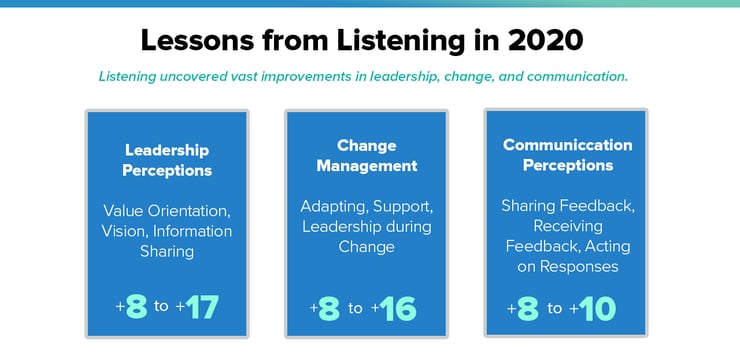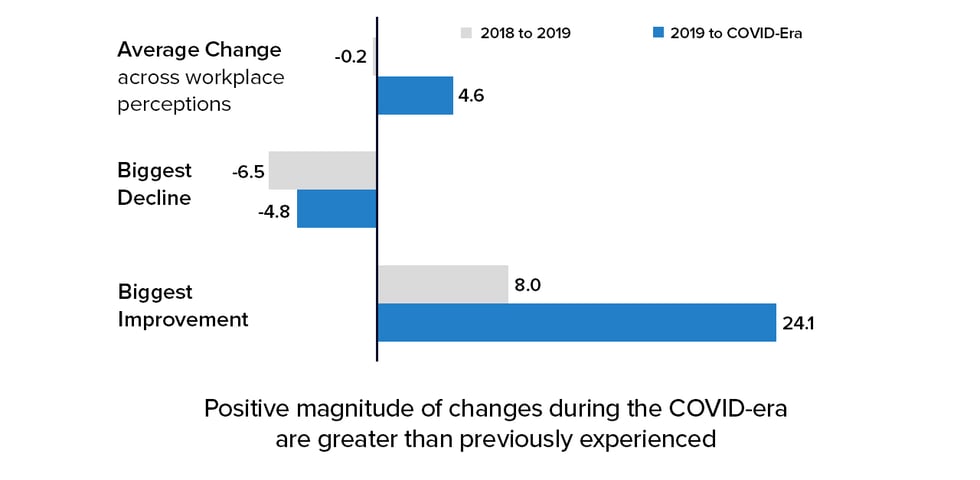If 2020 has taught us anything, it is that uncertainty is certain. Individuals across the globe have adapted personally and professionally as the COVID-19 pandemic uprooted normal routines and altered working conditions. Growing pains affected those who transitioned to remote work, while safety became a concern for those too essential to leave their workplace. Many people experienced negative outcomes as a result of these changes, including personal challenges with physical and mental well-being and professional challenges such as job loss and job instability.
Despite widespread coverage of these negative outcomes, research also reveals the emergence of some positive outcomes in 2020. The employee experience is one example.
When it comes to engagement and the employee experience, the COVID-19 pandemic has not only transformed many aspects of work but also led to rises in engagement. Josh Bersin even suggests “COVID-19 may be the best thing that ever happened to employee engagement,” as many organizations were challenged to adapt to the changing environment and rethink how work gets done, how messages get communicated, and how employee well-being is prioritized.
Research conducted by Perceptyx provides further insight into how engagement and the employee experience have changed so far and what we can anticipate next.
Employee Engagement Rises
For most of 2020, employee engagement improved, despite volatile and uncertain circumstances. Specifically, data from over 1.2 million employees collected from March through August 2020 (COVID-era) revealed engagement improved from 2019, a trend not replicated in previous years. This trend appeared across major industries and geographies as many employees felt an increased sense of pride in working at their companies and organizations transformed their operations.
Specifically, at the item level, increases were seen initially for pride in company (+2.3), referral behavior (+4.1), intent to stay (+2.3), and intrinsic motivation (+1.6). The first six months of the pandemic offered clear evidence that organizations that were listening and acting during turbulent times improved employee engagement significantly and rapidly. This finding magnifies the importance of surveying in times of change.
Employee Experience Improved
Besides higher engagement, employees also perceived better working environments overall since COVID-19 began. Approximately 140 different employee perceptions were examined, including leadership, development, recognition, teamwork, communication, resources, well-being, and inclusion. Across all these experiences, little change occurred year over year before 2020: In years prior, about half of employee perceptions improved slightly (e.g., feeling supported, feeling valued, communication) while half declined slightly (e.g., work-life balance, perceptions of benefits, clarity in expectations at work).
A starkly different story emerges in 2020, with 91% of perceptions improving from the pre-COVID to the COVID-era. Overall, most aspects of the employee experience improved for much of 2020, with the areas of leadership, change management, and communication improving the most.

The magnitude of positive changes experienced during the COVID-era were also greater than anything seen before. When comparing employee experiences before COVID-19, perceptions on average remained flat year over year. When comparing pre-covid to COVID-era perceptions, experiences on average improved 4.6 points. The biggest declines were smaller than seen in years past, and the biggest improvements were larger in the COVID-era, further supporting overall improvements in the employee experience from 2019 to much of 2020.

Engagement & The Employee Experience Beyond 2020
As seen above, research through August 2020 indicates a clear story for engagement and the employee experience as we know it: Organizations that listened to and acted upon employee feedback during most of 2020 saw improvements in the employee experience. However, if 2020 has taught us anything, it is that we can always expect the unexpected. Despite these improvements, more recent research suggests such trends are already reversing, or at minimum, shifting toward a new curve as more data is collected. In fact, many industries are seeing engagement and workplace experiences decline toward the end of 2020 as unavoidable burnout sets in, people become impatient, and the economy continues to challenge us.
If we truly learned any lessons from the data thus far, it is that now is the time to listen.
We must check in periodically to see how the circumstances around us are impacting our people during turbulent times of change, now more than ever. Pulse surveys are a great way to stay in touch and keep asking questions. Track changes in results, inform leaders, and communicate to team members to encourage stability in an ever-changing world.
As more data is collected, the picture will become clearer. Continue to listen and learn from the experiences of your own organization, and act upon those results.
